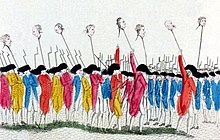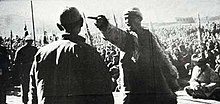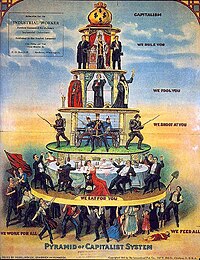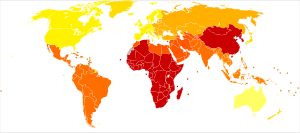The Pyramid of Capitalist System is a simple visualization of class conflict.
Class conflict, also referred to as class struggle and class warfare, is the political tension and economic antagonism that exists in society consequent to socio-economic competition among the social classes.
The forms of class conflict include direct violence, such as wars
for resources and cheap labor and assassinations; indirect violence,
such as deaths from poverty and starvation, illness and unsafe working
conditions. Economic coercion, such as the threat of unemployment or the
withdrawal of investment capital; or ideologically, by way of political
literature. Additionally, political forms of class warfare are: legal
and illegal lobbying, and bribery of legislators.
The social-class conflict can be direct, as in a dispute between labour and management, such as an employer's industrial lockout of their employees in effort to weaken the bargaining power of the corresponding trade union; or indirect, such as a workers' slowdown of production in protest of unfair labor practices, such as low wages and poor workplace conditions.
In the political and economic philosophies of Karl Marx and Mikhail Bakunin,
class struggle is a central tenet and a practical means for effecting
radical social and political changes for the social majority.
Usage
Truck drivers fight the police in the course of the Minneapolis Teamsters Strike of 1934
Heads of aristocrats on pikes
Farmer confronting landlord during Mao Zedong's mass purging of landlords
In political science, socialists and Marxists use the term class conflict to define a social class by its relationship to the means of production,
such as factories, agricultural land, and industrial machinery. The
social control of labor and of the production of goods and services, is a
political contest between the social classes.
The anarchist Mikhail Bakunin said that the class struggles of the working class, the peasantry, and the working poor were central to realizing a social revolution to depose and replace the ruling class, and the creation of libertarian socialism.
Marx's theory of history proposes that class conflict is decisive in the history of economic systems organized by hierarchies of social class, such as capitalism and feudalism. Marxists refer to its overt manifestations as class war, a struggle whose resolution in favor of the working class is viewed by them as inevitable under plutocratic capitalism.
Pre-capitalist societies
Where
societies are socially divided based on status, wealth, or control of
social production and distribution, class structures arise and are thus
coeval with civilization itself. It is well documented since at least
European classical antiquity (Conflict of the Orders, Spartacus, etc.) and the various popular uprisings in late medieval Europe and elsewhere. One of the earliest analysis of these conflicts is Friedrich Engels' The Peasant War in Germany.
One of the earliest analyses of the development of class as the
development of conflicts between emergent classes is available in Peter Kropotkin's Mutual Aid. In this work, Kropotkin analyzes the disposal of goods after death in pre-class or hunter-gatherer societies, and how inheritance produces early class divisions and conflict.
21st-century United States
In the speech "The Great American Class War" (2013), the journalist Bill Moyers asserted the existence of social-class conflict between democracy and plutocracy in the U.S. Chris Hedges wrote a column for Truthdig called "Let's Get This Class War Started," which was a play on Pink's song "Let's Get This Party Started."
Historian Steve Fraser, author of The Age of Acquiescence: The Life and Death of American Resistance to Organized Wealth and Power,
asserts that class conflict is an inevitability if current political
and economic conditions continue, noting that "people are increasingly
fed up… their voices are not being heard. And I think that can only go
on for so long without there being more and more outbreaks of what used
to be called class struggle, class warfare."
Capitalist societies
The
typical example of class conflict described is class conflict within
capitalism. This class conflict is seen to occur primarily between the bourgeoisie and the proletariat,
and takes the form of conflict over hours of work, value of wages,
division of profits, cost of consumer goods, the culture at work,
control over parliament or bureaucracy, and economic inequality.
The particular implementation of government programs which may seem
purely humanitarian, such as disaster relief, can actually be a form of
class conflict.
In the U.S., class conflict is often noted in labor/management
disputes. As far back as 1933 representative Edward Hamilton of ALPA,
the Airline Pilot's Association, used the term "class warfare" to describe airline management's opposition at the National Labor Board hearings in October of that year.
Apart from these day-to-day forms of class conflict, during periods of
crisis or revolution class conflict takes on a violent nature and
involves repression, assault, restriction of civil liberties, and
murderous violence such as assassinations or death squads.
Thomas Jefferson
Although Thomas Jefferson
(1743–1826) led the U.S. as president from 1801–1809 and is considered
one of the founding fathers, he died with immense amounts of debt.
Regarding the interaction between social classes, he wrote,
I am convinced that those societies (as the Indians) which live without government enjoy in their general mass an infinitely greater degree of happiness than those who live under the European governments. Among the former, public opinion is in the place of law, & restrains morals as powerfully as laws ever did anywhere. Among the latter, under pretence of governing they have divided their nations into two classes, wolves & sheep. I do not exaggerate. This is a true picture of Europe. Cherish therefore the spirit of our people, and keep alive their attention. Do not be too severe upon their errors, but reclaim them by enlightening them. If once they become inattentive to the public affairs, you & I, & Congress & Assemblies, judges & governors shall all become wolves. It seems to be the law of our general nature, in spite of individual exceptions; and experience declares that man is the only animal which devours his own kind, for I can apply no milder term to the governments of Europe, and to the general prey of the rich on the poor.
— Thomas Jefferson, Letter to Edward Carrington - January 16, 1787
Warren Buffett
The investor, billionaire, and philanthropist Warren Buffett, one of the wealthiest people in the world,
voiced in 2005 and once more in 2006 his view that his class – the
"rich class" – is waging class warfare on the rest of society. In 2005
Buffet said to CNN: "It's class warfare, my class is winning, but they
shouldn't be." In a November 2006 interview in The New York Times,
Buffett stated that "[t]here’s class warfare all right, but it’s my
class, the rich class, that’s making war, and we’re winning."
Later Warren gave away more than half of his fortune to charitable
causes through a program developed by himself and computer software
tycoon Bill Gates. In 2011 Buffett called on government legislators to, "...stop coddling the super rich."
Max Weber
Max Weber
(1864–1920) agrees with the fundamental ideas of Karl Marx about the
economy causing class conflict, but claims that class conflict can also
stem from prestige and power.
Weber argues that classes come from the different property locations.
Different locations can largely affect one's class by their education
and the people they associate with.
He also states that prestige results in different status groupings.
This prestige is based upon the social status of one's parents. Prestige
is an attributed value and many times cannot be changed. Weber states
that power differences led to the formation of political parties.
Weber disagrees with Marx about the formation of classes. While Marx
believes that groups are similar due to their economic status, Weber
argues that classes are largely formed by social status. Weber does not believe that communities are formed by economic standing, but by similar social prestige. Weber does recognize that there is a relationship between social status, social prestige and classes.
Arab Spring
Numerous factors have culminated in what's known as the Arab Spring. Agenda behind the civil unrest, and the ultimate overthrow of authoritarian governments throughout the Middle-East included issues such as dictatorship or absolute monarchy, human rights violations, government corruption (demonstrated by Wikileaks diplomatic cables), economic decline, unemployment, extreme poverty, and a number of demographic structural factors, such as a large percentage of educated but dissatisfied youth within the population. Also, some, like Slovenian philosopher Slavoj Žižek attribute the 2009 Iranian protests as one of the reasons behind the Arab Spring. The catalysts for the revolts in all Northern African and Persian Gulf countries
have been the concentration of wealth in the hands of autocrats in
power for decades, insufficient transparency of its redistribution,
corruption, and especially the refusal of the youth to accept the status
quo. as they involve threats to food security worldwide and prices that approach levels of the 2007–2008 world food price crisis. Amnesty International singled out WikiLeaks' release of U.S. diplomatic cables as a catalyst for the revolts.
Socialism
Marxist perspectives
Karl Marx, 1875
Karl Marx (1818–1883) was a German born philosopher who lived the majority of his adult life in London, England. In The Communist Manifesto, Karl Marx argued that a class is formed when its members achieve class consciousness and solidarity. This largely happens when the members of a class become aware of their exploitation
and the conflict with another class. A class will then realize their
shared interests and a common identity. According to Marx, a class will
then take action against those that are exploiting the lower classes.
What Marx points out is that members of each of the two main
classes have interests in common. These class or collective interests
are in conflict with those of the other class as a whole. This in turn
leads to conflict between individual members of different classes.
Marxist analysis of society identifies two main social groups:
- Labour (the proletariat or workers) includes anyone who earns their livelihood by selling their labor power and being paid a wage or salary for their labor time. They have little choice but to work for capital, since they typically have no independent way to survive.
- Capital (the bourgeoisie or capitalists) includes anyone who gets their income not from labor as much as from the surplus value they appropriate from the workers who create wealth. The income of the capitalists, therefore, is based on their exploitation of the workers (proletariat).
Not all class struggle is violent or necessarily radical, as with
strikes and lockouts. Class antagonism may instead be expressed as low
worker morale, minor sabotage and pilferage, and individual workers'
abuse of petty authority and hoarding of information. It may also be
expressed on a larger scale by support for socialist or populist
parties. On the employers' side, the use of union busting legal firms
and the lobbying for anti-union laws are forms of class struggle.
Not all class struggle is a threat to capitalism, or even to the
authority of an individual capitalist. A narrow struggle for higher
wages by a small sector of the working-class, what is often called
"economism", hardly threatens the status quo. In fact, by applying the
craft-union tactics of excluding other workers from skilled trades, an
economistic struggle may even weaken the working class as a whole by
dividing it. Class struggle becomes more important in the historical
process as it becomes more general, as industries are organized rather
than crafts, as workers' class consciousness rises, and as they
self-organize away from political parties. Marx referred to this as the
progress of the proletariat from being a class "in itself", a position
in the social structure, to being one "for itself", an active and
conscious force that could change the world.
Marx largely focuses on the capital industrialist society as the source of social stratification, which ultimately results in class conflict.
He states that capitalism creates a division between classes which can
largely be seen in manufacturing factories. The proletariat, is
separated from the bourgeoisie because production becomes a social
enterprise. Contributing to their separation is the technology that is
in factories. Technology de-skills and alienates workers as they are no
longer viewed as having a specialized skill. Another effect of technology is a homogenous workforce
that can be easily replaceable. Marx believed that this class conflict
would result in the overthrow of the bourgeoisie and that the private
property would be communally owned. The mode of production would remain, but communal ownership would eliminate class conflict.
Even after a revolution, the two classes would struggle, but
eventually the struggle would recede and the classes dissolve. As class
boundaries broke down, the state apparatus would wither away. According
to Marx, the main task of any state apparatus is to uphold the power of
the ruling class; but without any classes there would be no need for a
state. That would lead to the classless, stateless communist society.
Soviet Union and similar societies
A variety of predominantly Trotskyist and anarchist thinkers argue that class conflict existed in Soviet-style societies. Their arguments describe as a class the bureaucratic stratum formed by the ruling political party (known as the nomenklatura in the Soviet Union), sometimes termed a "new class", that controls and guides the means of production.
This ruling class is viewed to be in opposition to the remainder of
society, generally considered the proletariat. This type of system is
referred by them as state socialism, state capitalism, bureaucratic collectivism or new class
societies. (Cliff; Ðilas 1957) Marxism was such a predominate
ideological power in what became the Soviet Union since a Marxist group
known as the Russian Social Democratic Labour Party was formed in the country, prior to 1917. This party soon divided into two main factions; the Bolsheviks, who were led by Vladimir Lenin, and the Mensheviks, who were led by Julius Martov.
However, many Marxist argue that unlike in capitalism the Soviet elites did not own the means of production, or generated surplus value
for their personal wealth like in capitalism as the generated profit
from the economy was equally distributed into Soviet society. Even some Trotskyist like Ernest Mandel criticized the concept of a new ruling class as an oxymoron,
saying: "The hypothesis of the bureaucracy’s being a new ruling class
leads to the conclusion that, for the first time in history, we are
confronted with a “ruling class” which does not exist as a class before
it actually rules."
Non-Marxist perspectives
Social commentators, historians and socialist theorists had commented
on class struggle for some time before Marx as well as the connection
between class struggle, property, and law. This include Augustin Thierry, François Guizot, François-Auguste Mignet and Adolphe Thiers. The Physiocrats, David Ricardo, and after Marx, Henry George noted the inelastic supply of land and argued that this created certain privileges (economic rent) for landowners. According to the historian Arnold Toynbee,
stratification along lines of class appears only within civilizations,
and furthermore only appears during the process of a civilization's
decline while not characterizing the growth phase of a civilization.
Pierre-Joseph Proudhon, in What is Property?
(1840) states that "certain classes do not relish investigation into
the pretended titles to property, and its fabulous and perhaps
scandalous history."
While Proudhon saw the solution as the lower classes forming an
alternative, solidarity economy centered on cooperatives and
self-managed workplaces, which would slowly undermine and replace
capitalist class society, the anarchist Mikhail Bakunin,
while influenced by Proudhon, insisted that a massive class struggle by
the working class, peasantry and poor was essential to the creation of libertarian socialism. This would require a (final) showdown in the form of a social revolution.
Fascists
have often opposed class struggle and instead have attempted to appeal
to the working class while promising to preserve the existing social
classes and have proposed an alternative concept known as class collaboration.
Noam Chomsky
Noam Chomsky, 2004
Noam Chomsky, American linguist, philosopher, and political activist has criticized class war in the United States:
Well, there’s always a class war going on. The United States, to an unusual extent, is a business-run society, more so than others. The business classes are very class-conscious—they’re constantly fighting a bitter class war to improve their power and diminish opposition. Occasionally this is recognized... The enormous benefits given to the very wealthy, the privileges for the very wealthy here, are way beyond those of other comparable societies and are part of the ongoing class war. Take a look at CEO salaries....
— Noam Chomsky, OCCUPY: Class War, Rebellion and Solidarity, Second Edition (November 5, 2013)
Relation to race
Jobless black workers in the heat of the Philadelphia summer, 1973
Some historical tendencies of Orthodox Marxism reject racism, sexism, etc. as struggles that essentially distract from class struggle, the real conflict.
These divisions within the class prevent the purported antagonists from
acting in their common class interest. However, many Marxist
internationalists and anti-colonial revolutionaries believe sex, race and class to be bound up together. There is an ongoing debate within Marxist scholarship about these topics.
According to Michel Foucault, in the 19th century the essentialist notion of the "race" was incorporated by racists, biologists, and eugenicists, who gave it the modern sense of "biological race" which was then integrated to "state racism". On the other hand, Foucault claims that when Marxists
developed their concept of "class struggle", they were partly inspired
by the older, non-biological notions of the "race" and the "race
struggle". Quoting a non-existent 1882 letter from Marx to Friedrich
Engels during a lecture, Foucault erroneously claimed Marx wrote: You
know very well where we found our idea of class struggle; we found it
in the work of the French historians who talked about the race struggle. For Foucault, the theme of social war provides the overriding principle that connects class and race struggle.
Moses Hess, an important theoretician and labor Zionist of the early socialist movement, in his "Epilogue" to "Rome and Jerusalem" argued that "the race struggle is primary, the class struggle secondary... With the cessation of race antagonism, the class struggle will also come to a standstill. The equalization of all classes of society will necessarily follow the emancipation of all the races, for it will ultimately become a scientific question of social economics."
W. E. B. Du Bois theorized that the intersectional paradigms of race, class, and nation might explain certain aspects of black political economy. Patricia Hill Collins
writes: "Du Bois saw race, class, and nation not primarily as personal
identity categories but as social hierarchies that shaped
African-American access to status, poverty, and power."
In modern times, emerging schools of thought in the U.S. and other countries hold the opposite to be true.
They argue that the race struggle is less important, because the
primary struggle is that of class since labor of all races face the same
problems and injustices.









